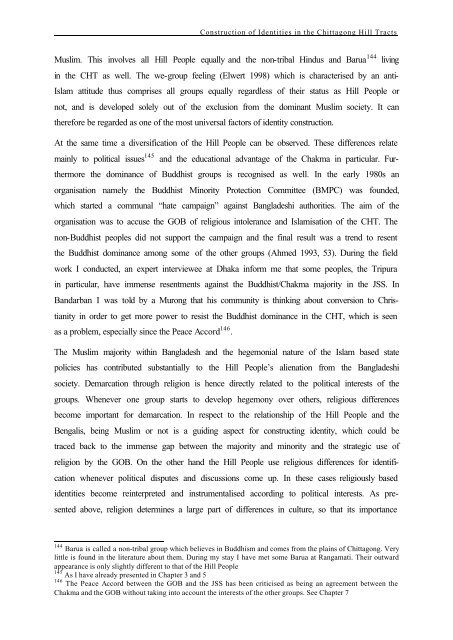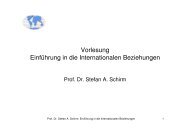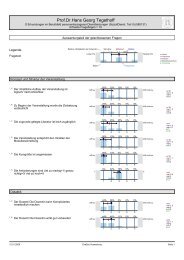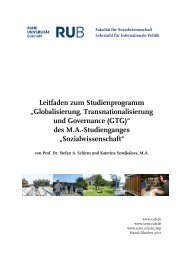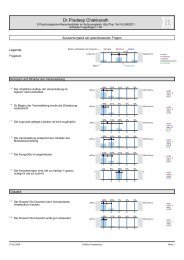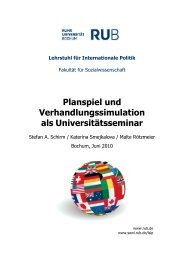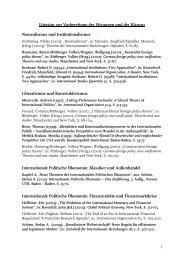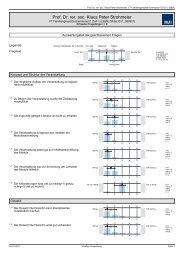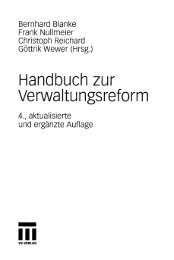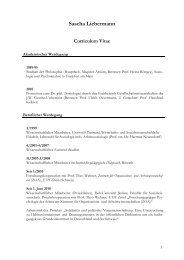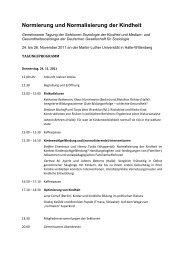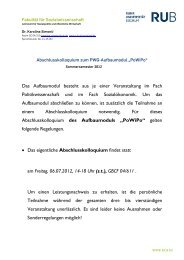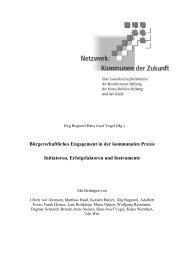Eva Gerharz: âThe Construction of Identities: The Case of the Chitta ...
Eva Gerharz: âThe Construction of Identities: The Case of the Chitta ...
Eva Gerharz: âThe Construction of Identities: The Case of the Chitta ...
Create successful ePaper yourself
Turn your PDF publications into a flip-book with our unique Google optimized e-Paper software.
<strong>Construction</strong> <strong>of</strong> <strong>Identities</strong> in <strong>the</strong> <strong>Chitta</strong>gong Hill Tracts<br />
Muslim. This involves all Hill People equally and <strong>the</strong> non-tribal Hindus and Barua 144 living<br />
in <strong>the</strong> CHT as well. <strong>The</strong> we-group feeling (Elwert 1998) which is characterised by an anti-<br />
Islam attitude thus comprises all groups equally regardless <strong>of</strong> <strong>the</strong>ir status as Hill People or<br />
not, and is developed solely out <strong>of</strong> <strong>the</strong> exclusion from <strong>the</strong> dominant Muslim society. It can<br />
<strong>the</strong>refore be regarded as one <strong>of</strong> <strong>the</strong> most universal factors <strong>of</strong> identity construction.<br />
At <strong>the</strong> same time a diversification <strong>of</strong> <strong>the</strong> Hill People can be observed. <strong>The</strong>se differences relate<br />
mainly to political issues 145 and <strong>the</strong> educational advantage <strong>of</strong> <strong>the</strong> Chakma in particular. Fur<strong>the</strong>rmore<br />
<strong>the</strong> dominance <strong>of</strong> Buddhist groups is recognised as well. In <strong>the</strong> early 1980s an<br />
organisation namely <strong>the</strong> Buddhist Minority Protection Committee (BMPC) was founded,<br />
which started a communal “hate campaign” against Bangladeshi authorities. <strong>The</strong> aim <strong>of</strong> <strong>the</strong><br />
organisation was to accuse <strong>the</strong> GOB <strong>of</strong> religious intolerance and Islamisation <strong>of</strong> <strong>the</strong> CHT. <strong>The</strong><br />
non-Buddhist peoples did not support <strong>the</strong> campaign and <strong>the</strong> final result was a trend to resent<br />
<strong>the</strong> Buddhist dominance among some <strong>of</strong> <strong>the</strong> o<strong>the</strong>r groups (Ahmed 1993, 53). During <strong>the</strong> field<br />
work I conducted, an expert interviewee at Dhaka inform me that some peoples, <strong>the</strong> Tripura<br />
in particular, have immense resentments against <strong>the</strong> Buddhist/Chakma majority in <strong>the</strong> JSS. In<br />
Bandarban I was told by a Murong that his community is thinking about conversion to Christianity<br />
in order to get more power to resist <strong>the</strong> Buddhist dominance in <strong>the</strong> CHT, which is seen<br />
as a problem, especially since <strong>the</strong> Peace Accord 146 .<br />
<strong>The</strong> Muslim majority within Bangladesh and <strong>the</strong> hegemonial nature <strong>of</strong> <strong>the</strong> Islam based state<br />
policies has contributed substantially to <strong>the</strong> Hill People’s alienation from <strong>the</strong> Bangladeshi<br />
society. Demarcation through religion is hence directly related to <strong>the</strong> political interests <strong>of</strong> <strong>the</strong><br />
groups. Whenever one group starts to develop hegemony over o<strong>the</strong>rs, religious differences<br />
become important for demarcation. In respect to <strong>the</strong> relationship <strong>of</strong> <strong>the</strong> Hill People and <strong>the</strong><br />
Bengalis, being Muslim or not is a guiding aspect for constructing identity, which could be<br />
traced back to <strong>the</strong> immense gap between <strong>the</strong> majority and minority and <strong>the</strong> strategic use <strong>of</strong><br />
religion by <strong>the</strong> GOB. On <strong>the</strong> o<strong>the</strong>r hand <strong>the</strong> Hill People use religious differences for identification<br />
whenever political disputes and discussions come up. In <strong>the</strong>se cases religiously based<br />
identities become reinterpreted and instrumentalised according to political interests. As presented<br />
above, religion determines a large part <strong>of</strong> differences in culture, so that its importance<br />
144 Barua is called a non-tribal group which believes in Buddhism and comes from <strong>the</strong> plains <strong>of</strong> <strong>Chitta</strong>gong. Very<br />
little is found in <strong>the</strong> literature about <strong>the</strong>m. During my stay I have met some Barua at Rangamati. <strong>The</strong>ir outward<br />
appearance is only slightly different to that <strong>of</strong> <strong>the</strong> Hill People<br />
145 As I have already presented in Chapter 3 and 5<br />
146 <strong>The</strong> Peace Accord between <strong>the</strong> GOB and <strong>the</strong> JSS has been criticised as being an agreement between <strong>the</strong><br />
Chakma and <strong>the</strong> GOB without taking into account <strong>the</strong> interests <strong>of</strong> <strong>the</strong> o<strong>the</strong>r groups. See Chapter 7


